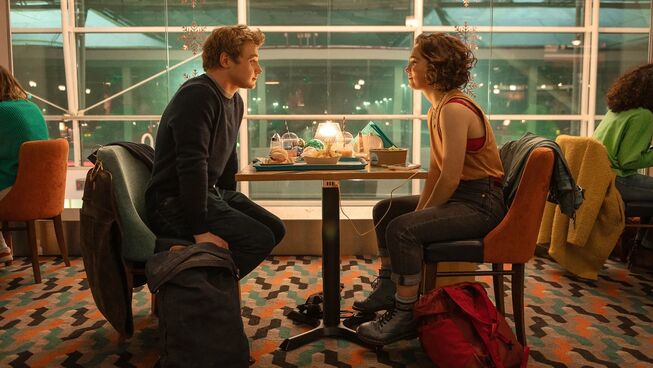A Comparison of Netflix's 'Love at First Sight' to Jennifer E. Smith's Young Adult Novel

Haley Lu Richardson and Ben Hardy star in our latest Netflix romantic comedy obsession, Love at First Sight, which was adapted from Jennifer E. Smith’s 2012 novel of a nearly identical name.
Smith’s The Statistical Probability of Love at First Sight kicked off with high school senior Hadley Sullivan narrowly missing her flight to London for her dad’s second wedding. Her replacement flight seats her beside British college student Oliver, who is returning home for a funeral. Throughout the course of the novel, the twosome connect over life, love and everything in between — in a single day.
It was announced in April 2022 that Netflix planned to bring Smith’s bestselling words to life starring Richardson and Hardy as Hadley and Oliver, respectively.
“They’ve shortened the title, but it’s still the same story you’ve loved all these years, and I hope you’ll love the film version just as much,” Smith wrote via Instagram in January, referring to the film’s abbreviated name.
Love at First Sight premiered Friday, September 15, on Netflix.
Keep reading for a breakdown of how Love at First Sight compares to its literary inspiration:
While the book versions of Hadley and Oliver are 17 and 18, respectively, they’ve been aged up for the big screen treatment. In the film, Hadley is 20 and Oliver is two years older than her at 22.
Eagle-eyed book lovers will note that the movie took a few liberties with some minuscule details, especially in regard to Hadley’s bridesmaid dress (maroon in color instead of lavender) and the location and venue of Hadley and Oliver’s respective events. (For what it is worth: Shoreditch and Kensington are two very distinct areas in London, as are Paddington and Peckham.)
Perhaps the biggest change was the plane seating configuration. In The Statistical Probability of Love at First Sight, Hadley and Oliver are assigned the window and aisle seats in row 18. (Oliver ends up taking the middle seat to chat with Hadley, switching spots with an older woman.) In the Netflix flick, they both end up seated in a business-class two-seater.
There is no narrator as a person in the book, which meant a role was added in the film for Jameela Jamil. The Good Place alum even popped into various scenes as different characters to help move the story along.
Oliver, who is given the surname Jones in the movie despite never having a last name in the novel, has a completely different background. In the book, he is the youngest of three boys and is estranged from his father, whose funeral he was set to attend. In the movie, Oliver just has one brother and he is close to his happily married parents. The funeral is a “living memorial” for his mother, who is dying of cancer.
The new backstory allowed viewers to also see the story from Oliver’s side instead of solely Hadley’s point-of-view like the novel.
While Hadley was upset with her dad, Andrew Sullivan, in both the book and movie for leaving her family post-divorce, she leaned on her mom on the page. Hadley’s mother was not featured in the movie nor was Hadley’s almost-stepfather Harrison. (Movie Hadley’s phobia of dentists had Us wondering if it was a subtle reference to Harrison’s dental profession.)
With the movie giving more access to Oliver, it also allowed fans (and Hadley) to go into his mom’s memorial and meet his family. As pointed out above, the tweak allows viewers to see Oliver’s emotions and vulnerabilities whereas he was a fairly one-dimensional book love interest.
Book Hadley and her dad had a huge bond over Charles Dickens and his novel Our Mutual Friend. The movie left that connection completely intact.
Faithful book readers will be delighted that several exact lines and jokes were replicated in the Netflix script — including the last scene’s final dialogue when Oliver mutters the complete book title for the first time.




